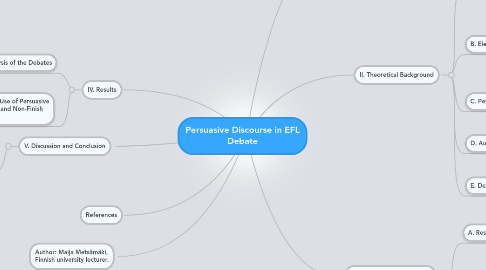
1. IV. Results
1.1. A. Analysis of the Debates
1.1.1. Students used several elements of persuasion, as Aristotle defined.
1.2. B. Comparisonof the Use of Persuasive Tools between Finish and Non-Finish Students
1.2.1. A comparative perspective showed that non-Finnish participants used the three persuasive means, logical reasoning, restructuring and appeals, more frequently then the Finnish students. Collaborative strategies were used by both groups which were equally comitted to the task.
2. V. Discussion and Conclusion
2.1. Earlier studies have shown that Finnish students lack the ability of using paralinguistic tools when debating, which could be noticed in this study too. However, it is changing because of other cultures influences, and Finish students are nowadays more likely to use them. Further studied need to be done in order to improve students's debating skills.
3. References
4. Author: Maija Metsämäki, Finnish university lecturer.
5. I. Introduction Article's objective: investigating elements of persuasive discourse in EFL debate
6. II. Theoretical Background
6.1. A. History of Persuasive Discourse
6.1.1. Rethoric was defined and studied by Aristotle in antique times and nowadays it is an interdisciplinary academic discipline. Knowing that persuasion is differente in each culture avoids conflicts. Language is powerful (discursive power), therefore awareness of persuasive strategies is essential.
6.2. B. Elements of Persuasive Discourse
6.2.1. According to Aristotle, rethoric is discovering the possible means of persuasion in reference to any sucject whatever. This shows that being aware of it helps in many fields of society. Aristotle distinguishes three kinds of structural principles of persuasion: by moral (ethos), emotionally (pathos) and by reasoning.
6.3. C. Persuasive Message
6.3.1. Clearly articulated main issue and ideas to support it. It can be locucionary (the speaker), illocionary (the massage) or perlocucionary act (effect of the message).
6.4. D. Audience/Listeners/Opponents
6.4.1. Althoug not the most important role in the debate, it is certainly essential. The discussion depends on its audience.
6.5. E. Debate
6.5.1. Assertive interaction between two parties, affirmative and negative, with differente views on given topics (Ylikoski, 1987). The is pro and a con side, generaly with a moderator. It normally deals with opinios and beliefs.
7. III. Research questions, data, and methods
7.1. A. Research Questions
7.1.1. 1. What kinds of rethorical means are students able to use in a demanding debating situation in English? 2. What kinds of crosscultural differences are there in Finnish and non-Finnish university students' use of persuasive discourse?
7.2. B. Data Collection
7.2.1. Finnish and non-Finnish university students on a videorecorded debate in English. Level of proficiency: highr intermidiate of advanced level.
7.3. C. Method
7.3.1. Divided in four groups without previously knowlegde of the themes of the debates, then subdivided into "For" and "Against". After the debates, students answered a questionaire on it, and their studies of English and on their on evaluation.
